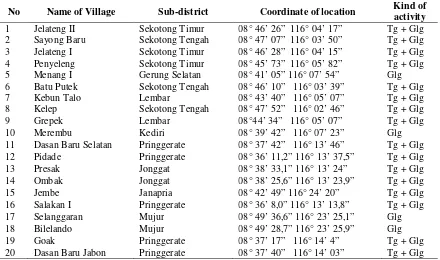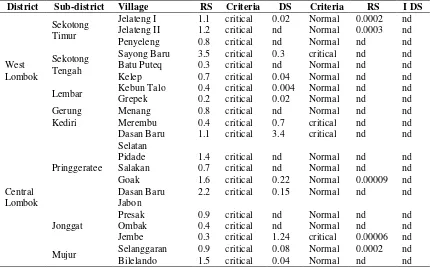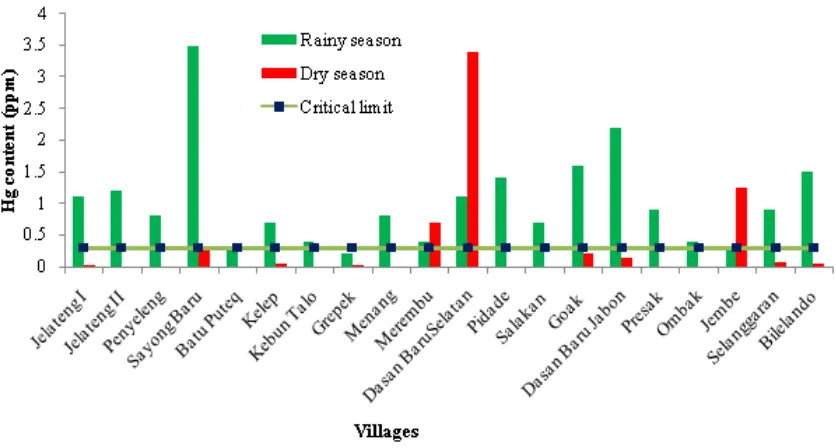ISSN: 2339-076X (e); 2502-2458 (p), Volume 3, Number 3 (April 2016): 559-564
DOI:10.15243/jdmlm.2016.033.559
www.jdmlm.ub.ac.id 559
Research Article
Mercury content in wetland rice soil and water of two different seasons
at small-scale gold mine processing areas
T. Sugianti
1*, F. Zulhaedar
1, S.F. Batubara
21
Institute for Agricultural Technology (BPTP) of West Nusa Tenggara, Jl. Raya Peninjauan Narmada West Lombok NTB-83371, Indonesia
2
Institute for Agricultural Technology (BPTP) of North Sumatra, Jl. Jend. Besar AH. Nasution No 1 B Medan-20143, Indonesia
corresponding author: [email protected]
Abstract:
This study was aimed to identify the impact of small-scale gold processing activities on mercury content in wetland rice soil and water during the rainy and first dry seasons in Central Lombok and West Lombok Districts. The method used for this study was survey method. Measurement of mercury levels in water samples was conducted at Agro Bogor Centre using SNI 6989.77: 2011 methods. The data was collected and processed in a simple statistic presented descriptively, in order to obtain information. Results of the study showed that mercury content soils in the rainy season exceeded the threshold of 0.005 ppm, while in the first dry season the mercury content in soil decreased, but it was still above the threshold value permitted. The contents of mercury in water samples in the rainy season and the first dry season were still at a safe point that was less than 0.05 ppm. The wetland rice soil and water had been polluted with mercury, although the mercury content in the water was still below the threshold, but the accumulation of mercury that could have been absorbed by the plants are of particular concerns. The decrease of mercury content in soil in dry season was due to lack of gold processing activities.Keywords :mercury content, planting season, wetland rice,
Introduction
One of issues of the 2003-2009 Medium Term Development Plan of West Nusa Tenggara Province in Indonesia is the deterioration of environmental quality. Strategies to address the issue is made by optimizing the empowerment of spatial and environment management with the use of sciences and technologies. For this purpose, the direction of general policy made is to improve the environmental quality and capacity with holistic control that supports all industrial and agricultural subsectors for agricultural and environmental sustainability.
There are two seasons in Indonesia, particularly in West Nusa Tenggara, i.e. rainy season and dry season. The length of dry season, and the short of rainy season and the heavy rainfall at a given time cannot be separated from the El-Nino and La-Nina (Wikipedia, 2013). In Lombok Island, the majority of wetland rice can
be cultivated during the rainy season and the first dry season, because of the sufficient water supply for irrigation. This also affects small-scale gold processing activities that operate during the rainy season and the first dry season as the activities require water.
Iyan, 2011; Hoedoafia et al., 2014), there is several environmental damage caused by the activity (Hilson, 2002b; Kessey and Arko, 2013).
According to Polii and Sonya (2002), mercury can enter human body through food and breathing. Mercury that enters to the human body will be able to poison and damage the nervous system of the brain, and cause birth defects as happened in the case of Minamata Bay, Japan. The disposal of mercury waste to seawater that was conducted by PT Newmont over years in Manado has resulted in contamination of fish in the water. The mercury-contaminated fish that are consumed by people around the area caused an outbreak of not contagious neurology that was very detrimental to health as well as the devastation of public health.
The main sources of heavy metal contaminants are from the air and water that contaminate soil. Plants that grow on the contaminated soil will in turn accumulate the metals in all plant parts (roots, stems, leaves and fruit) (Supriadi, 2010). Livestock will then harvest the heavy metals in plants and accumulated in parts of the meat.
Human that belongs to the omnivore group will then be contaminated with the heavy metals from four main sources, namely the inhaled air when breathing, drinking water, plants (vegetables and fruits), and livestock (such as meat, eggs, and milk) (Widaningrum et al., 2007). It has been reported that water, soil, and air pollution caused by mining waste resulted in the decreased level of children health, increased respiratory and gastrointestinal diseases, decreased agricultural output which in turn results in the increase of poverty rates of farmers and citizens around mining regions (Aragon and Rud, 2012)
Based on the problems generated from mercury toxicity due to the small-scale gold processing activities, this study was aimed to identify the impact of small-scale gold processing activities on mercury contents in soil and water of wetland rice during the rainy and dry seasons in West Nusa Tenggara Province of Indonesia
Materials and Methods
The study was conducted on the rainy season and the first dry season from March to September 2013. Locations of the study were on wetland rice in Central Lombok and West Lombok Districts. The selection of the study areas was based on information about small-scale gold processing activities in both districts.
Materials used for the study included soil and water samples collected from gold processing
areas and wetland rice surrounding soil sampling points with the radius of 0-10 m. Another material used for the study was a map of earth that was used as the basis for making a sampling point distribution map and description of soil and water analyses. Several chemical reagents were used in the laboratory for soil analysis purposes. Field equipment used included GPS, soil augers, plastic bags, labels, and stationery. Instrument used for data analysis was a computer set supported by several software including ArcGIS 10.0 for spatial analysis.
The method used in this study was a survey method. Secondary data were collected from Environment Agency of West Nusa Tenggara Province, Environment Agency of West Lombok District, and Environment Agency of Central Lombok District. Mapping activity that was carried out by observation along villages and sub-districts of each district. The map was then used for determination of observation points based location points for sampling of soil and water. Samples were taken from areas affected by the discharge of wastewater of small-scale gold processing activities. Ten observation points were assigned for each district. Soil and water sampling was conducted at each sampling point with a proportional random sampling technique. The sampling was conducted twice, i.e. at rainy season and at first dry season. Analysis of mercury content in the collected soil samples was conducted at Bogor Soil Testing Laboratory with Hydride Vapour Generator method using Atomic Absorption Spectrophotometer. Analysis of mercury content in the collected water samples was conducted at Agro Bogor Centre using SNI 6989.77: 2011 methods. The data obtained were then processed in a simple statistic presented descriptively in order to obtain factual information.
The sampling sites in West Lombok and Central Lombok District are wetland rice areas that are usually planted with rice and ‘palawija’ with planting pattern of palawija, rice-palawija-fallow, and rice-horticulture-fallow. There are primary irrigation canals nearby the study areas. Data of soil and water sampling areas in West Lombok and Central Lombok Districts are presented in Tables 1 and 2.
processing activities are at Sekotong Sub-district. Those in Central Lombok District are found at Pringgerate and Jonggat Sub-districts. Most of the activities use ‘gelondong’ (rotary mill) and ‘tong’ (drum).
One of factors that makes the areas have many small-scale gold processing units is the availability of water as the main ingredient to support gold processing. There are 20 small-scale
gold processing areas that are intersected directly with wetland rice in West Lombok and Central Lombok Districts. The selection of gold processing locations under wetland rice by gold miners was based on the consideration to reduce noise pollution in residential areas. The ‘gelondong’ processing units operate 24 hours with a rest period of 1 to 2 hours every 3 hours.
Table 1. Location of soil and water sampling in West Lombok and Central Lombok Districts
No Name of Village Sub-district Coordinate of location Kind of
activity
1 Jelateng II Sekotong Timur 08° 46’ 26” 116° 04’ 17” Tg + Glg
2 Sayong Baru Sekotong Tengah 08° 47’ 07” 116° 03’ 50” Tg + Glg
3 Jelateng I Sekotong Timur 08° 46’ 28” 116° 04’ 15” Tg + Glg
4 Penyeleng Sekotong Timur 08° 45’ 73” 116° 05’ 82” Tg + Glg
5 Menang I Gerung Selatan 08° 41’ 05” 116° 07’ 54” Glg
6 Batu Putek Sekotong Tengah 08° 46’ 10” 116° 03’ 39” Tg + Glg
7 Kebun Talo Lembar 08° 43’ 40” 116° 05’ 07” Tg + Glg
8 Kelep Sekotong Tengah 08° 47’ 52” 116° 02’ 46” Tg + Glg
9 Grepek Lembar 08°44’ 34” 116° 05’ 07” Tg + Glg
10 Merembu Kediri 08° 39’ 42” 116° 07’ 23” Glg
11 Dasan Baru Selatan Pringgerate 08° 37’ 42” 116° 13’ 46” Tg + Glg
12 Pidade Pringgerate 08° 36’ 11,2” 116° 13’ 37,5” Tg + Glg
13 Presak Jonggat 08° 38’ 33,1” 116° 13’ 24” Tg + Glg
14 Ombak Jonggat 08° 38’ 25,6” 116° 13’ 23,9” Tg + Glg
15 Jembe Janapria 08° 42’ 49” 116° 24’ 20” Tg + Glg
16 Salakan I Pringgerate 08° 36’ 8,0” 116° 13’ 13,8” Tg + Glg
17 Selanggaran Mujur 08° 49’ 36,6” 116° 23’ 25,1” Glg
18 Bilelando Mujur 08° 49’ 28,7” 116° 23’ 25,9” Glg
19 Goak Pringgerate 08° 37’ 17” 116° 14’ 4” Tg + Glg
20 Dasan Baru Jabon Pringgerate 08° 37’ 40” 116° 14’ 03” Tg + Glg
Remarks : Tg : gold processing activities using ‘tong’ (drum) , Glg : gold processing activates using ‘gelondong’ (rotary mill)
Results and Discussion
Based on data collection of small-scale gold processing activities in West Lombok and Central Lombok Districts, miners use mercury to capture and separate gold from the rock grains. Mercury sediment is filtered using cloth to get the rest of the gold. When the activity scale is small, miners just use their hands to filter out the mercury sediment. The miners even rely on the precision of the eye for panning gold captured by mercury, which miners paid attention to the movements of mercury deposition. The precipitate obtained is then kneaded or pressed using fingers. Wastewater generated from leaching of mining remnants containing mercury is allowed to flow
into the river and sources of irrigation for agricultural land.
The highest mercury content was found at Sayong Baru Village, Central Sekotong Sub-district of West Lombok District (3.5 ppm), and the Dasan Baru Jabon Village, Pringgerate Sub-district of Central Lombok District (2.2 ppm). The average mercury content in the dry season decreased within normal limits. There were only 4 points having critical mercury contents.
Unlike other locations, the mercury contents at three points of Merembu, Dasan Baru Selatan, and Jembe Vilages increased. This was because the processing of gold did not operate anymore that made accumulation of waste and slow movement of waste. Accumulation of mercury in the environment, particularly on agricultural land, can be toxic to plants and microorganisms. Results of analysis showed that mercury content in the soil during the rainy season was higher than that in the first dry season. One of the factors influencing the mobilization of Hg in the soil is environment pH. The pH value between five and seven will raise the value of the mercury concentration in the water because the low pH affects water holding capacity of mercury (SLHD Prov. Gorontalo, 2013).
The interview data showed that the intensity of small-scale gold gold processing activities
during the rainy season was high because it was supported by the availability of water as the main material used from ‘gelondong’ and puddling process until ‘tong’ process. This is thought to be one factor contributing to higher mercury content in the rainy season than in the dry season. Almost all sampling locations had mercury content exceeding the critical limit in the rainy season, whereas in the dry season there were only Dasan Baru Selatan and Jembe Villages, which had mercury content exceeding the critical limit (Figure 2).
Mercury content in irrigation water samples at wetland rice areas were below the defined threshold of 0.002 ppm (WHO, 2004). With the detection at some points, it is necessary to watch out for the quality of irrigation water used as source of irrigation in the region that is detected to contain mercury. Based on the results of the mercury content analysis in the second period of sampling at the first dry season harvest, the mercury content in soil samples at various sampling points decreased. According to data of Meteorological and Geofisical Agency of Selaparang Mataram monitoring station in 2013 (BMKG, 2013), the pH of normal rainwater from was 5.4.
Table 3. Mercury content in soil sample (ppm) in rainy season and first dry season in West Lombok and Central Lombok Districts
District Sub-district Village RS Criteria DS Criteria RS I DS
West Lombok
Sekotong Timur
Jelateng I 1.1 critical 0.02 Normal 0.0002 nd
Jelateng II 1.2 critical nd Normal 0.0003 nd
Penyeleng 0.8 critical nd Normal nd nd
Sekotong Tengah
Sayong Baru 3.5 critical 0.3 critical nd nd
Batu Puteq 0.3 critical nd Normal nd nd
Kelep 0.7 critical 0.04 Normal nd nd
Lembar Kebun Talo 0.4 critical 0.004 Normal nd nd
Grepek 0.2 critical 0.02 Normal nd nd
Gerung Menang 0.8 critical nd Normal nd nd
Kediri Merembu 0.4 critical 0.7 critical nd nd
Central Lombok
Pringgeratee
Dasan Baru Selatan
1.1 critical 3.4 critical nd nd
Pidade 1.4 critical nd Normal nd nd
Salakan 0.7 critical nd Normal nd nd
Goak 1.6 critical 0.22 Normal 0.00009 nd
Dasan Baru Jabon
2.2 critical 0.15 Normal nd nd
Jonggat
Presak 0.9 critical nd Normal nd nd
Ombak 0.4 critical nd Normal nd nd
Jembe 0.3 critical 1.24 critical 0.00006 nd
Mujur Selanggaran 0.9 critical 0.08 Normal 0.0002 nd
Bilelando 1.5 critical 0.04 Normal nd nd
Figure 2. The dynamics of mercury content analysis in soil samples at each point of observation in West Lombok and Central Lombok Districts.
Hence, rainwater has the potential to increase total mercury content to be in the rainy season than in the dry season. After the mercury reaches the surface of water or soil and combining with carbon, it forms organic Hg compounds by microorganisms (bacteria) in water and soil. Hg compounds are detected high in the rainy season.
The most common organic mercury compound is methyl mercury, a substance that can be quickly absorbed by most organisms. Results of analysis showed that mercury content in water from the rainy season was far below the allowable threshold. This was also shown in the data of analysis results in the dry season. This happened because there was very little mercury compounds that can dilute in water and most of them are not hydrated. Based on the chemical nature, mercury is the most volatile metal compared with other metals. Distribution of heavy metals due to the traditional gold mining waste is determined by soil conditions such as temperature effect, and the disintegration of rocks. Various biological and microbiological processes can localize metals into the soil. Heavy metal typically accumulates at a soil depth of above 75 cm (Wilkison et al., 2003; Raikwar et al., 2008).
Conclusion
Mercury content in wetland rice soil at various points of West Lombok and Central Lombok Districts had exceeded the permitted threshold. Mercury content in soil in the rainy season was
higher than that in the dry season. The decrease of mercury content in soil in dry season was due to lack of gold processing activities.
References
Alloway, B.J. 1995. Heavy metals in soils. Blackie Academic and Professional.
Aragon, F.M. and Rud, J.P. 2012. Mining, pollution and agriculture production Evidence from Ghana. BMKG, 2013. Tingkat Keasaman (pH) Air Hujan di
Indonesia Juni 2013.
http://www.bmkg.go.id/bmkg_pusat/Klimatologi/In formasiKAH.bmkg diakses 08 Januari 2014. Eriyati and Iyan, R.Y. 2011. Dampak ekonomi dan
lingkungan penambangan emas liar di Desa Kebun Lado Kecamatan Singingi Kabupaten Kuantan Singingi.Jurnal Ekonomi19: 135-143.
Hilson, G. 2002a. Small-scale mining and its socio-economic impact in developing countries.A United Nations Sustainable Development Journal26: 3-13. Hilson, G. 2002b. The environmental impact of small-scale gold mining in Ghana: identifying problems and possible solution. The Geographical Journal
168: 57-72.
Hoedoafia, M.A., Cheabu, B.S.N. and Korang, V. 2014. The effects of small scale gold mining on living conditions: A case study of the west gonja district of Ghana. OnternationalJournal of Social Scinence Research2:151-164.
Junizar. 2012. Documenting the spread of mercury in Cibaliung mining areas, Pandeglang district, Banten Province. Geological Resources Centre, West Java. Kessey, K.D. and Arko B. 2013. Small scale gold
mining policy impelemntation and challenges.
Journal of Studies in Social Sciences5:12-30. Polii, B.J. and Sonya, D.N. 2002. Estimation of the
content of Mercury and cyanide watershed area (DAS) Buyat Minahasa. Ekoton Vol 2 No. 1; 31-37.
ISSN 1412-3487.
ejournal.unsrat.ac.id/index.php/ekoton.
Raikwar, M.K., Kumar, P., Singh, M. and Singh, A. 2008. Toxic effect of heavy metals in livestock health.Veterinary World.1 (1): 28-30.
SLHD Prov Gorontalo, 2013. Impact of Mercury (Hg) Contamination. Environmental status of Gorontalo Province
.http://lingkunganhidup.gorontaloprov.go.id/berita-provinsi/89-dampak-pencemaran-merkuri-hg. Access date 21 Januari 2014
Supriadi. 2010. Decreasing risk of mercury on small-scale gold processing. http;//tavivsupriadi, wordpress.com/pengurangan-resiko-bahaya-merkuri.
Tangkuman, H.D., Abidjulu, J. and Mukuan, H. 2008. Influence of cyanide consentration on gold production. Chemical study programme of MIPA faaculty Fakultas MIPA, UNSRAT Manado. Chem. Prog. Vol. 1, No. 1, 2008. http://
ejournal.unsrat.ac.id/index.php/chemprog/article
WHO. 2004. Hydrogen cyanide and cyanides : Human health aspects ; Conicies International Chemical Assessment document 61. Geneva.
Widaningrum, Miskiyah. dan Suismono. 2007. Dangerous of heavy metal contamination on vegetable and prevention alternative. http://pascapanen litbang. Deptan.go.id
Wikipedia. 2013. Indonesian Geografy. Wikipedia.org/wiki/geografi_Indonesia access date 21 Januari 2014.


